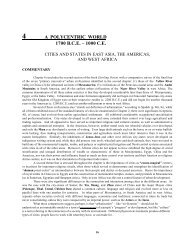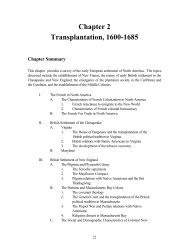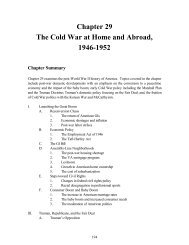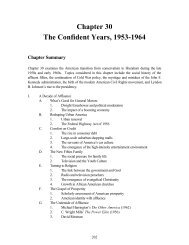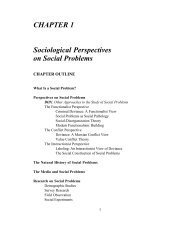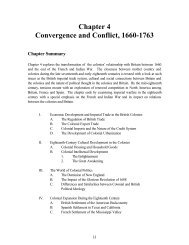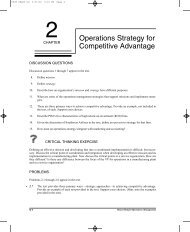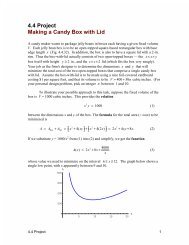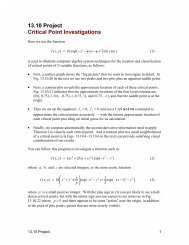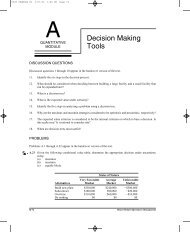Merchandising Operations and the Accounting Cycle - Pearson
Merchandising Operations and the Accounting Cycle - Pearson
Merchandising Operations and the Accounting Cycle - Pearson
You also want an ePaper? Increase the reach of your titles
YUMPU automatically turns print PDFs into web optimized ePapers that Google loves.
KEY POINT<br />
The recording of cost of goods sold<br />
along with sales revenue is an<br />
example of <strong>the</strong> matching principle<br />
(Chapter 3, page 111)—matching<br />
expense against revenue to<br />
measure net income.<br />
232 Part One The Basic Structure of <strong>Accounting</strong><br />
•Asales discount: If <strong>the</strong> customer pays within <strong>the</strong> discount period—under<br />
terms such as 2/10 n/30—Austin Sound collects <strong>the</strong> discounted amount.<br />
•Freight out: Austin Sound may have to pay Delivery Expense to transport <strong>the</strong><br />
goods to <strong>the</strong> buyer’s location.<br />
The sale of inventory may be for cash or on account, as Exhibit 5-2 shows.<br />
Cash Sale Sales of retailers, such as grocery stores <strong>and</strong> restaurants, are often for<br />
cash. Cash sales of $3,000 would be recorded by debiting Cash <strong>and</strong> crediting Sales<br />
Revenue as follows:<br />
Jan. 9 Cash.............................................................................. 3,000<br />
Sales Revenue........................................................ 3,000<br />
Cash sale.<br />
To update <strong>the</strong> inventory records, <strong>the</strong> business also must decrease <strong>the</strong> Inventory<br />
balance. Suppose <strong>the</strong>se goods cost <strong>the</strong> seller $1,900. An accompanying entry is<br />
needed to transfer <strong>the</strong> $1,900 cost of <strong>the</strong> goods—not <strong>the</strong>ir selling price of $3,000—<br />
from <strong>the</strong> Inventory account to <strong>the</strong> Cost of Goods Sold account as follows:<br />
Jan . 9 Cost of Goods Sold..................................................... 1,900<br />
Inventory................................................................ 1,900<br />
Recorded <strong>the</strong> cost of goods sold.<br />
Cost of goods sold (also called cost of sales) is <strong>the</strong> largest single expense of most businesses<br />
that sell merch<strong>and</strong>ise, such as Bombardier, JVC, <strong>and</strong> Austin Sound. It is <strong>the</strong><br />
cost of <strong>the</strong> inventory that <strong>the</strong> business has sold to customers. The Cost of Goods<br />
Sold account keeps a current balance as transactions are journalized <strong>and</strong> posted.<br />
After posting, <strong>the</strong> Cost of Goods Sold account holds <strong>the</strong> cost of <strong>the</strong> merch<strong>and</strong>ise<br />
sold ($1,900 in this case):<br />
Inventory Cost of Goods Sold<br />
Purchases 50,000 Jan. 9 1,900 Jan. 9 1,900<br />
(amount<br />
assumed)<br />
The computer automatically records this entry when <strong>the</strong> cashier keys in <strong>the</strong> code<br />
number of <strong>the</strong> inventory that is sold. Optical scanners at cash registers perform this<br />
task in most stores.<br />
Sale on Account Most sales in Canada are made on account (on credit) using ei<strong>the</strong>r<br />
<strong>the</strong> seller’s credit facility or a credit card such as Visa or MasterCard. To simplify<br />
<strong>the</strong> discussion, we will assume <strong>the</strong> seller records <strong>the</strong> receivable as a regular<br />
account receivable ra<strong>the</strong>r than a special receivable from <strong>the</strong> credit card company. A<br />
$5,000 sale on account is recorded by a debit to Accounts Receivable <strong>and</strong> a credit to<br />
Sales Revenue, as follows:<br />
Jan. 11 Accounts Receivable .................................................. 5,000<br />
Sales Revenue........................................................ 5,000<br />
Sale on account.<br />
If we assume that <strong>the</strong>se goods cost <strong>the</strong> seller $2,900, <strong>the</strong> accompanying cost of goods<br />
sold <strong>and</strong> inventory entry is<br />
Jan . 11 Cost of Goods Sold..................................................... 2,900<br />
Inventory................................................................ 2,900<br />
Recorded <strong>the</strong> cost of goods sold.<br />
After recording <strong>the</strong> January 9 <strong>and</strong> 11 transactions, sales revenue is $8,000 ($3,000<br />
+ $5,000). Cost of goods sold totals $4,800 ($1,900 + $2,900).<br />
The seller records <strong>the</strong> related cash receipt on account as follows:<br />
Jan . 19 Cash.............................................................................. 5,000<br />
Accounts Receivable............................................. 5,000<br />
Collection on account.



